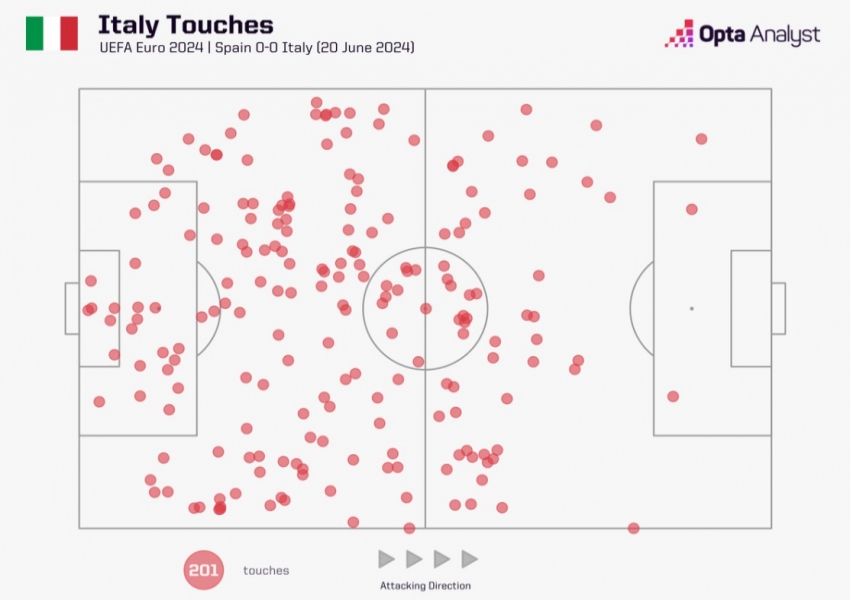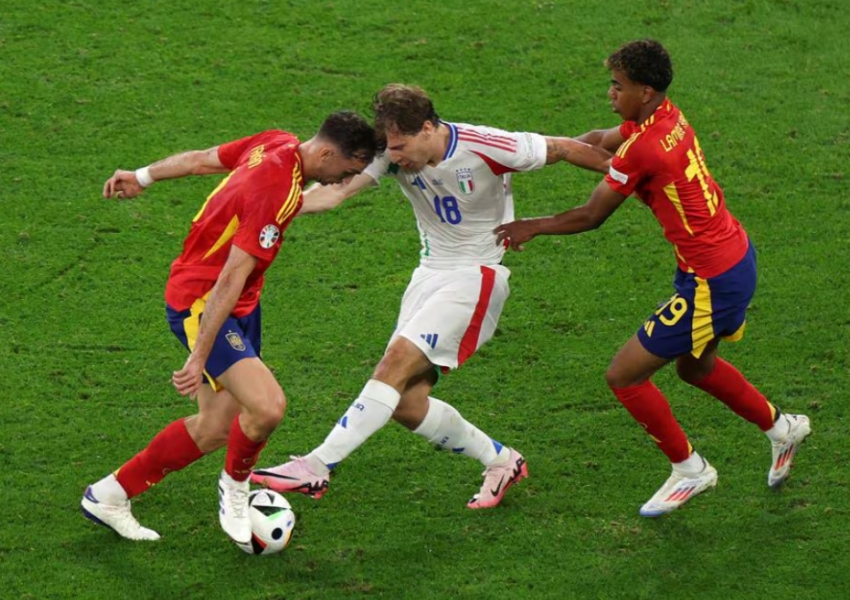Italy's Tactical Misstep: A Fork-and-Knife Approach in Football Leads to Historical Humiliation; Inter Milan Stars Misplaced as New Toldo Emerges
Italy's recent 0-1 defeat to Spain was far from a narrow loss suggested by the scoreline. In reality, it should have been a one-sided thrashing. Numerous indicators support this assertion. After the match, Gianluigi Donnarumma sat on the pitch in disbelief, having made nine critical saves—five of which were classified as "Big Chances" by OPTA—yet he couldn't even secure a draw. The last time an Italian goalkeeper produced such a stellar individual performance in a major tournament was 24 years ago, during the "Toldo Miracle" at the 2000 European Championship.

The statistics further illustrate Italy's struggles. The team managed only 201 touches throughout the match, a stark indicator of their lack of control and offensive presence. Their touches in the attacking third and inside the opponent's penalty area were virtually non-existent, emphasizing how they were dominated by Spain. The notion that Italy was merely "scraped off the floor" by Spain would not be an exaggeration.

Who was the worst performer on the field? On the surface, Giovanni Di Lorenzo, the Italian right-back, was deemed the culprit, receiving the lowest ratings from Gazzetta dello Sport and Marca. Di Lorenzo was completely outclassed, allowing Spain to exploit their advantage and apply constant pressure on Italy's midfield and defense, ultimately draining their energy and resilience.

However, a deeper analysis reveals that the root of Italy's problems lay in tactical decisions. Many football analysts on social media agree that Italy's issue was akin to serving rice with a fork and knife—unfit tools for the task. Seven out of Italy's ten outfield players are accustomed to playing in a three-man defense at their clubs. However, coach Luciano Spalletti insisted on deploying a four-man defense, a formation he prefers. This decision forced several players into uncomfortable and unfamiliar roles, limiting their effectiveness.
Take Alessandro Bastoni, for example. Bastoni, a left-footed center-back known for his technical precision, progression, and long passing, thrives as a left-center-back in a three-man defense. Spalletti, however, placed him as a right-center-back in a four-man defense, negating Bastoni's strengths. Despite his commendable physical condition (winning 6 out of 7 duels in the match), Bastoni couldn't cover Di Lorenzo's deficiencies or contribute to the offense as he does at Inter Milan.
Similarly, Nicolò Barella, typically a right-sided mezzala in Inter Milan's three-man midfield, was shoehorned into a restrictive left-sided role. In the previous match against Albania, Barella played as a free-roaming midfielder, covering more ground and performing well. However, against Spain, he was confined to the left, often finding himself in difficult situations. Although his physical performance was commendable (covering the most ground, making three tackles, and winning 6 out of 8 duels with an 85% pass accuracy), his overall impact was limited.
Federico Dimarco, another wing-back accustomed to a three-man defense, was also out of his element in a four-man backline. Dimarco's strengths in overlapping runs and offensive support were nullified, forcing him to focus on defensive responsibilities, where he struggled.
In essence, Italy's players, particularly those from Inter Milan, were forced into roles that did not suit their strengths. Spalletti's preference for a 4-3-3 or 4-2-3-1 formation overrode the players' natural inclinations, resulting in a disjointed and uncomfortable performance.
This tactical rigidity led to widespread criticism of Spalletti. On social media, fans from different clubs drew unfavorable comparisons. AC Milan supporters likened Spalletti to Stefano Pioli, Juventus fans compared him to Massimiliano Allegri, and Inter Milan fans went a step further, equating him to Gian Piero Ventura, infamous for Italy's failure to qualify for the 2018 World Cup.
Despite the defeat, Italy's chances of progressing in the tournament remain intact. With 24 teams competing and 16 advancing, one loss is not catastrophic. The group stage serves as a warm-up, a time to identify issues and adjust accordingly. La Gazzetta dello Sport's front page, titled "Little Italy," posed a critical question: If a draw against Croatia could secure advancement, should Italy aim higher? Should they reconsider their tactical approach—either by changing the formation or selecting different players?
Spalletti's decision to stick with a four-man defense reflects a broader philosophical debate in football: Should tactics be designed to suit the players, or should players adapt to the tactics? In this case, Spalletti chose the latter, and the results were evident on the pitch.
The performance of Italy's goalkeeper, Gianluigi Donnarumma, was one of the few positives. His nine saves, five of which were from clear goal-scoring opportunities, kept Italy in the match. Dubbed the "new Toldo," Donnarumma's heroics were reminiscent of Francesco Toldo's legendary performance at Euro 2000. However, without adequate support from his teammates, Donnarumma's efforts were in vain.
Italy's tactical missteps were further highlighted by the performances of their Inter Milan stars, Bastoni and Barella. Both players, accustomed to a three-man defense, were out of their comfort zones in Spalletti's four-man system. This mismatch not only affected their individual performances but also disrupted the team's overall cohesion.
Bastoni, known for his ability to progress the ball from the back and deliver precise long passes, was misused as a right-center-back. This position nullified his strengths and exposed him to unfamiliar challenges. Barella, similarly, was forced to adapt to a role that did not play to his strengths. His natural inclination to cover large areas of the pitch and support the attack was curtailed by his restrictive left-sided position.
Dimarco, another casualty of Spalletti's tactical rigidity, struggled to adapt to a traditional left-back role. His strengths as a wing-back, providing width and offensive support, were nullified. Forced to focus on defensive duties, Dimarco's effectiveness was significantly reduced.
In conclusion, Italy's defeat to Spain was a stark reminder of the importance of aligning tactics with players' strengths. Spalletti's decision to impose his preferred formation on a squad largely accustomed to a different system resulted in a disjointed and ineffective performance. The Italian team's struggles underscore the need for flexibility and adaptability in tactical planning. As the tournament progresses, Italy must reconsider their approach to avoid further disappointment and maximize the potential of their talented squad.
Copyright Statement:
Author: mrfootballer
Source: Mrfootballer
The copyright of this article belongs to the author. Reproduction is not allowed without permission.
Recommended Blog
- Euro 2024 Round of 16: Can England Capitalize on Their Bracket? Spain Displaying Championship Caliber
- Italy's Best Player Reveals True Culprit with Four Major Sins: Draconian Discipline Becomes a Laughingstock
- Euro 2024 Group E Final Round: Romania Poised to Leverage Technical Edge, Belgium's Unsettling Atmosphere
- Euro 2024 Group D Final Round: Should the Netherlands Trust Depay? France and Poland Await Star Players' Starts
- Inter Milan's Defensive Star Tops Key Euro 2024 Rankings: From Mascot to Mainstay in Three Years
- Inter Milan's Chief Scouts Rising Swiss Star: A €30 Million Transfer Saga Unfolds
- Final Round of Euro 2024 Group B: Italy's Golden Opportunity, Spain's Rotation Strategy
- Final Round of Euro 2024 Group A: Germany's Declining Form, Scotland's Spirited Battle Against Hungary
- Inter's Justification for Hakan Çalhanoğlu's €70 Million Valuation: Rejecting a €20 Million Annual Offer
- Dragon Tail Flick! Inter Milan's Crafted Skill Shines for French Striker Amidst Midfielder Pursued by Bayern
Hot Blog
- Man City’s 21-Year-Old Star Returns Home as a Hero! Receives $350,000 Mercedes, Gifts It to His Father
- AFC Champions League Quarterfinal Draw: Yokohama Faces CR7! Two High-Stakes Clashes as Japan’s Duo Battle in the Bottom Half
- 175 Days on the Sidelines! Barça’s 32-Year-Old Guardian Dreams of a Champions League Comeback
- English Media: Manchester United Will Win Premier League Title in 2028! History Will Repeat Itself, Two Teams Serve as Inspirations
- 4 AM Showdown: Barcelona's Revenge Match! Win = 3-Point Lead Over Real Madrid, Key Players Rested
- 0-2 Double Defeat! China National Team Stuck at 6 Points: No More Direct World Cup Hopes, Two Crucial Matches Ahead
- China National Football Team Drops 13.6 Points, Slips to 94th in FIFA Rankings: Syria Overtakes, New 9-Year Low
- 0-0 Draw! Japan 12 Shots, 2 Missed One-on-Ones: 8 Matches, 20 Points, Group Winner, Saudi Arabia Stuck at 10 Points in 3rd
- 4-1, Double Win Over Brazil! Argentina Celebrates: World Cup Qualification Secured, 4th Team Globally to Qualify
- Real Madrid Got Lazy: 7 Kilometers Less Running in UCL! Two Superstar Spectators While Barça Outruns Them All